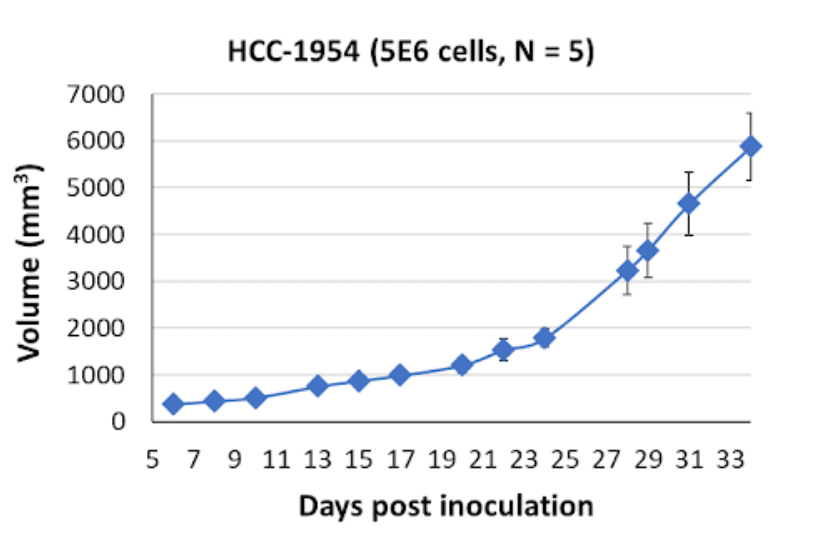About HCC-1954
The HCC1954 cell line was derived from a tumor of a 54-year-old woman diagnosed with infiltrating ductal carcinoma of the breast. It was first established in 1995 by the Adi Gazdar lab. HCC1954 cells exhibit epithelial-like characteristics and grow as a monolayer in culture. This cell line has been instrumental in advancing the understanding of breast cancer biology, particularly in relation to cell signaling pathways. A key feature of the HCC1954 cell line is its overexpression of the human epidermal growth factor receptor 2 (HER2).
HER2 is a member of the HER family of receptor tyrosine kinases (RTKs) and plays a critical role in cell growth, survival, and proliferation. The HER2 gene is amplified in a significant proportion of breast cancer cases, leading to increased HER2 protein expression on the cell surface. The overexpression of HER2 in HCC1954 cells indicates dysregulation of the HER2 signaling pathway, which is implicated in the development and progression of breast cancer. The HER2 signaling pathway is involved in several downstream signaling cascades, including the PI3K/AKT/mTOR pathway and the MAPK/ERK pathway. Activation of HER2 leads to the recruitment and phosphorylation of downstream effectors, triggering a series of intracellular events that promote cell proliferation, survival, and migration. Dysregulation of the HER2 pathway in HCC1954 cells contributes to their aggressive phenotype and may be associated with resistance to certain therapies.
In addition to HER2 overexpression, the HCC1954 cell line carries a mutation in the BRCA1 gene. BRCA1 is a caretaker gene involved in DNA repair and maintenance of genomic stability. Mutations in BRCA1, as seen in HCC1954, are associated with an increased risk of breast and ovarian cancers. The presence of the BRCA1 mutation in HCC1954 cells makes this cell line a valuable model for studying the downstream effects of caretaker gene dysfunction and exploring therapeutic strategies targeting DNA repair pathways.
The HCC1954 cell line has also been used to investigate the efficacy of treatments that disrupt the Brpf1 pathway. Brpf1, a bromodomain and PHD finger-containing protein, is involved in chromatin remodeling and transcriptional regulation. Disruption of Brpf1 function in HCC1954 cells has shown promising results as a cell growth and proliferation inhibitor, suggesting that targeting the Brpf1 pathway could be a potential therapeutic strategy for HER2-positive breast cancer.
When xenografted into animal models, HCC1954 cells form relatively large, cystic tumors. This tumor phenotype reflects the aggressive nature of HCC1954 cells and provides an in vivo platform for studying tumor growth, angiogenesis, and response to therapeutic interventions.
HCC-1954 Tumor Kinetics in the SRG™ Rat

HCC1954 tumor growth in Hera’s SRG Rat.
Products & Services
Xenograft Efficacy Studies
Includes collection of blood, tissues & tumor for ADME, PK/PD and analysis.
(Bi)weekly Tumor Sampling
Via fine needle aspiration (FNA). For longitudinal evaluation of drug exposure, histology and gene expression.
OncoRats
Cutting edge models optimized for engraftment.
Get help with your research by scheduling a call with Hera.
References
- 10.1039/c5mb00101c
- https://doi.org/10.1155/1998/298530
- https://doi.org/10.1371/journal.pone.0078398
- Rubin, I., and Yosef Yarden. “The basic biology of HER2.” Annals of oncology 12 (2001): S3-S8.
References MLA
- Ersahin, Tulin, et al. “The PI3K/AKT/Mtor Interactive Pathway.” Molecular BioSystems, 20 Apr. 2015, pubs.rsc.org/en/content/articlelanding/2015/MB/C5MB00101C.
- Fong, Jason T., et al. “Alternative Signaling Pathways as Potential Therapeutic Targets for Overcoming EGFR and C-MET Inhibitor Resistance in Non-Small Cell Lung Cancer.” PLOS ONE, 4 Nov. 2013, journals.plos.org/plosone/article?id=10.1371%2Fjournal.pone.0078398.
- Paterson, James W.E. “Brcal: A Review of Structure and Putative Functions.” Disease Markers, 1998, www.hindawi.com/journals/dm/1998/298530/.
- Yarden, Rubin. “The Basic Biology of HER2.” Annals of Oncology : Official Journal of the European Society for Medical Oncology, 2001, pubmed.ncbi.nlm.nih.gov/11521719/.
